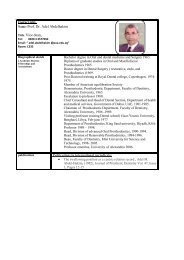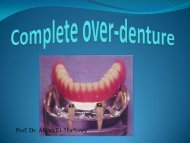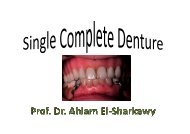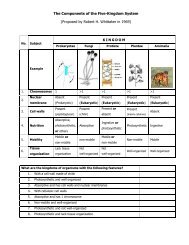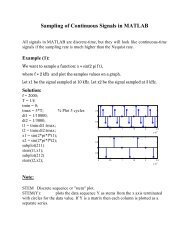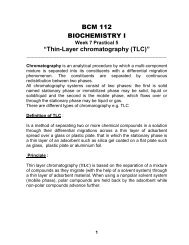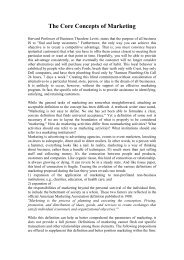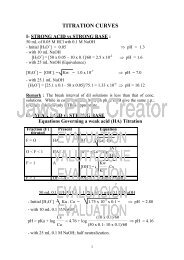Classification of implants according to position: I. Endodontic ...
Classification of implants according to position: I. Endodontic ...
Classification of implants according to position: I. Endodontic ...
Create successful ePaper yourself
Turn your PDF publications into a flip-book with our unique Google optimized e-Paper software.
<strong>Classification</strong> <strong>of</strong> <strong>implants</strong> <strong>according</strong> <strong>to</strong><br />
<strong>position</strong>:<br />
I. <strong>Endodontic</strong> stabilizer<br />
II.Mucosal inserts<br />
III- Subperioteal implant.<br />
IV- Transosteal implant.<br />
V- Endosteal <strong>implants</strong>
I-<strong>Endodontic</strong> stabilizer<br />
• It is a Smooth or threaded metallic pin implant<br />
that extends through the root canal in<strong>to</strong> the<br />
periapical bone <strong>to</strong> stabilize the mobile <strong>to</strong>oth.<br />
This was first used by Cuswell and Senia in<br />
1983
II-Mucosal inserts (Mucoperiosteal -<br />
implant interface)<br />
• They are stainless steel inserts attached <strong>to</strong> the<br />
tissue surface <strong>of</strong> a removable prosthesis that<br />
mechanically engage undercuts in surgically<br />
prepared mucosal sites.
III- Subperiosteal <strong>implants</strong>:<br />
• Its framework is made <strong>of</strong> cobalt chromium<br />
molybdenum based alloy resting on the<br />
alveolar bone beneath the periosteum, with<br />
abutment posts and intraoral bars <strong>to</strong> attach a<br />
abutment posts and intraoral bars <strong>to</strong> attach a<br />
prosthesis
Because there is <strong>of</strong>ten not enough bone in which <strong>to</strong> place an<br />
endosteal implant, dentists turned <strong>to</strong> placing <strong>implants</strong> on and<br />
around bone. Silicon impression material is used for this record.<br />
The metal frame was casted with four abutments designed <strong>to</strong><br />
perforate the covering mucoperiostium <strong>to</strong> give support <strong>to</strong> a<br />
denture.<br />
The second stage was performed for fixation <strong>of</strong> the casted metal<br />
frame <strong>to</strong> rest on bone and <strong>to</strong> be covered by the mucoperiosteal<br />
tissues.
IV-Transmandibular (transosseous)<br />
dental <strong>implants</strong> “stapleboneplates”:<br />
• - The staple bone plate is used <strong>to</strong> rehabilitate<br />
the atrophic edentulous mandible.<br />
• - It is a transosteal threaded posts which<br />
penetrate the full thickness <strong>of</strong> the mandible<br />
and pass in<strong>to</strong> the oral cavity in the<br />
parasymphysial area
V- Endosteal (Endosseous) <strong>implants</strong>:<br />
- The implant is placed in<strong>to</strong> the alveolar bone and<br />
composed <strong>of</strong> anchorage component (body) and a<br />
retentive component (abutment).<br />
- Endosseous <strong>implants</strong> are the most frequently used<br />
<strong>implants</strong> <strong>to</strong>day for fixed, fixed detachable<br />
prosthesis, overdenture and incases <strong>of</strong> single <strong>to</strong>oth<br />
replacement
1- <strong>Classification</strong> <strong>of</strong> endosseous<br />
<strong>implants</strong> <strong>according</strong> <strong>to</strong><br />
their design:<br />
A- Blade form endosseous <strong>implants</strong>.<br />
B -Root form endosseous <strong>implants</strong>.<br />
1-Cylinders endosseous <strong>implants</strong><br />
2- Screws or spiral post endosseous <strong>implants</strong>.
Blade form endosteal implant.<br />
• It is a wedge shaped implant composed <strong>of</strong> head, neck and<br />
body with vents which develops fibro osseous integration<br />
with bone.<br />
• The blade implant is a mean <strong>of</strong> utilizing the narrow and/<br />
or shallow areas <strong>of</strong> remaining alveolar bone where<br />
dimensions do not permit the use <strong>of</strong> root form <strong>implants</strong>.<br />
• The blade implant was res<strong>to</strong>rable within a month <strong>of</strong><br />
placement by the superstructure.
Endosseous Ramus Frame Implants<br />
The Ramus Frame implant was developed in 1970and was<br />
first fabricated from stainless steel. In 1982, the fabrication<br />
process was changed <strong>to</strong> titantium
Root form <strong>implants</strong><br />
The endosteal implant shaped in the approximate shape <strong>of</strong> the<br />
<strong>to</strong>oth root ,<br />
- It may be used for fixed, removable or fixed detachable<br />
prosthesis.<br />
- It requires more than 10 mm vertical bone height, more than<br />
6mm buccolingual thickness, and more then 8mm mesiodistal<br />
width <strong>to</strong> avoid undesirable complications.
Cylinders endosseous <strong>implants</strong>.
Screws or spiral post endosseous<br />
<strong>implants</strong>.
2- <strong>Classification</strong> <strong>of</strong> endosseous<br />
<strong>implants</strong> <strong>according</strong> <strong>to</strong><br />
their material<br />
• a- Pure titanium: the titanium oxide surface<br />
was responsible for the formation <strong>of</strong> the<br />
direct bone- implant interface.<br />
• b- Titanium alloy: the titanium alloys exist in<br />
three forms: alpha, beta and alpha beta<br />
phases and they all originate when pure<br />
titanium is heated and mixed with aluminium<br />
and vanadium
3- <strong>Classification</strong> <strong>of</strong> endosseous<br />
<strong>implants</strong> <strong>according</strong> <strong>to</strong><br />
surface characteristics:<br />
• a- Sand blasted surface.<br />
• b- Titanium Plasma Sprayed surface (TPS), it<br />
has satisfac<strong>to</strong>ry results regarding the<br />
osseointegration and the clinical prognosis.<br />
• c- Titanium oxide surface: coating the<br />
<strong>implants</strong> <strong>to</strong> make the inert metal a bioactive<br />
one.<br />
• d- Hydroxyapetite coating
4- <strong>Classification</strong> <strong>of</strong> endosseous<br />
<strong>implants</strong> <strong>according</strong> <strong>to</strong><br />
the insertion technique:<br />
a- Press fit technique, in this type <strong>of</strong> unthreaded <strong>implants</strong>, the implant site is<br />
drilled slightly smaller than the actual implant size, where the implant is<br />
pressed in<strong>to</strong> the recipient site with slight friction.<br />
b- Self tapping technique, in this type <strong>of</strong> threaded <strong>implants</strong>, the implant<br />
threads are used <strong>to</strong> tap its site during insertion.<br />
c- Pre-tapping technique, in case <strong>of</strong> very dense bone, the implant sites are<br />
better <strong>to</strong> be previously tapped using the bone tap instrument before insertion<br />
<strong>of</strong> the threaded implant.
5- <strong>Classification</strong> <strong>of</strong> endosseous<br />
<strong>implants</strong> <strong>according</strong> <strong>to</strong><br />
surgical stages:<br />
a- Single stage design (none submerged – transgingival):<br />
the body <strong>of</strong> the implant is inserted in<strong>to</strong> the bone with<br />
its abutment portion penetrating through the<br />
mucoperiosteum during the healing period.<br />
.
- Two stage design: in this design the implant<br />
body is completely embedded in bone for<br />
complete osseointegration. The implant body<br />
is then exposed and the healing abutment is<br />
placed for s<strong>of</strong>t tissue healing before the<br />
impression is made for prosthesis fabrication
<strong>Classification</strong> <strong>of</strong> endosseous <strong>implants</strong><br />
<strong>according</strong> <strong>to</strong><br />
the time <strong>of</strong> installation:<br />
a- Immediate <strong>implants</strong>, they are placed in<strong>to</strong> a prepared<br />
extraction socket following <strong>to</strong>oth extraction.<br />
b- Immediate delayed <strong>implants</strong>, they are placed within 6-<br />
12 weeks after the <strong>to</strong>oth loss.<br />
c- Delayed <strong>implants</strong>, they are placed within 6-12 months<br />
after <strong>to</strong>oth extraction, when complete healing and bone<br />
remodeling occur.
<strong>Classification</strong> <strong>of</strong> endosseous <strong>implants</strong><br />
<strong>according</strong> <strong>to</strong><br />
time <strong>of</strong> prosthetic loading:<br />
a- Immediately loaded <strong>implants</strong>, an acrylic resin prosthesis<br />
which is designed <strong>to</strong> be out <strong>of</strong> occlusion is placed<br />
immediately after implant placement, specially in anterior<br />
region for esthetic purposes.<br />
b- Delayed loading implant, delayed loading is done in<br />
maxillary <strong>implants</strong> after 4-6 months and in mandibular<br />
<strong>implants</strong> after 3-4 months <strong>to</strong> allow for better osseointegration



